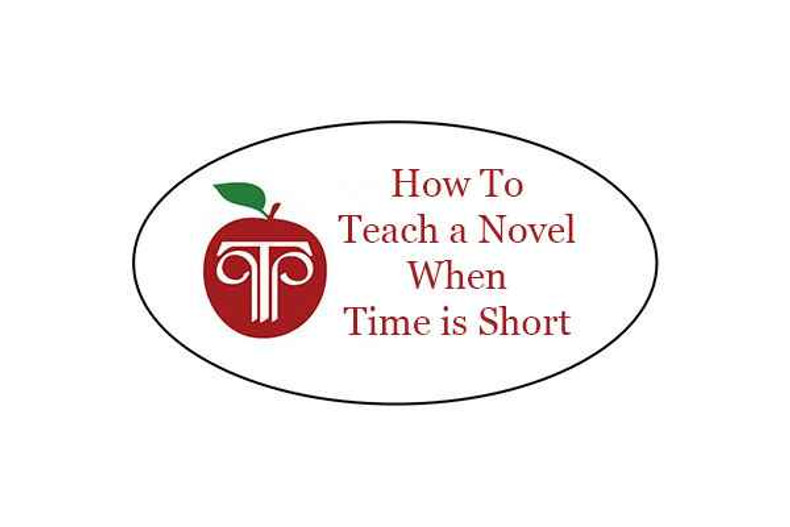Most of us would like to have six weeks to explore our favorite novel with our students, but sometimes that just isn’t practical. Too many other things have to fit into our limited class time. So, how do you teach a novel when time is short?
Approach #1: Focus On The Essentials
Why are you teaching this book, anyway? Answer that question and focus on reaching that objective. “Because it’s in the curriculum and my supervisor says I have to” won’t work as an answer. Here are a few possibilities:
To teach analytical reading
To educate students about this historical time period
To explore the theme of ____
To make students aware of ___
To have material as a springboard to improve students’ oral discussion skills
To have material as a springboard for practicing writing skills
To study the author’s writing style
To foster cooperative learning skills
Ideally, teaching literature covers a multitude of these objectives. However, when time is really short, choose one or two that are the most important and focus on them.
Which one(s) should you choose? That depends on the book you’re studying, the students you have, and your curriculum. What do your students need most? What does the book lend itself best to? What objectives do you have to meet at this time? Answer those questions, and you’ll know what to do.
How do you do it, though? Well, if your goal is to teach analytical reading, for example, it would be important to delve into portions of the book in great detail analyzing the figurative language, allusions, inferences, slant or bias, effects of events of the author’s life or the historical time period on the work, etc.
●You should model this kind of analysis with your students in the first part of the book and scaffold them over to being able to do it themselves by the end of the book.
●Do you have to do it for every chapter? No. Choose the passages that most lend themselves to this kind of analysis.
●There’s no need to focus on extensive vocabulary work or extensive writing assignments; focus on the analysis--class discussion, small group discussions. Give students passages to work on together in small groups, asking them to answer specific questions. Have groups swap passages and analyses. Figuratively poke them and get them thinking.
These are just a few ideas. Use your creativity and knowledge of your students to accomplish your objective(s).
Likewise, if your objective is to improve students’ vocabulary through the author’s exceptional vocabulary, you would spend less time on analysis of allusions or the historical time period--and more time on words, word usage, word meanings, etc.
If you have a class of poor readers, focus on practicing tips and tricks for improving reading and let the deep analytics go. If you have good readers, let them read the book at home and use your class time for more interesting things. Maybe they’re good readers but lousy writers. In that case, don’t pour over the minutia of basic comprehension and vocabulary; get on to writing!
The point is: you don’t have to make every novel meet every objective in the whole curriculum. You don’t have to practice every possible skill when teaching a novel. Choose what really needs to be done and focus a couple of weeks on that.
Approach #2 Divide and Conquer
Unless you have a directive that says so, no one says that every student has to read every word of the novel himself or herself. If you have a challenging book or are short on time, divide up the reading. Make individual students or small groups of students responsible for certain sections of the book. 10 chapters in the book? 30 students in your class? 3 students are responsible for chapter 1, 3 other students are responsible for chapter 2, etc.
What does it mean to “be responsible for” a section of the book? That depends on you, your students, and your objectives. It could mean they are responsible for reading that part of the book and relaying to the rest of the class what happens in that section. It could mean they also are responsible for vocabulary, analysis, leading a class discussion of important elements, written responses, or any other criteria you choose.
The fact is that the reading of the book is what usually takes the most amount of time when doing a novel unit. By dividing that up, you accomplish several things:
●The task of reading the book is less daunting to students.
●The reading of the book goes faster.
●You have more time for skills work, writing, analysis, etc.
●Students often become more interested, wondering what happened before their part and what happens after their part.
And don’t fret that this is “cheating.” Sometimes slogging through a difficult book with every student reading every word turns into boring drudgery and students just “turn off.” Again, think of your objectives. What do you really want to accomplish in this novel unit? Is the objective for every student to read every page, or is your objective really something else?
These two approaches don’t need to be employed for every novel. Most often, having every student read every page of a book is a good thing--and it should be done. But it doesn’t HAVE to be done in every novel unit. When you’re short on time or doing a book that is uber-challenging, these approaches can make life in your classroom a lot more pleasant while still accomplishing your most important objectives.




